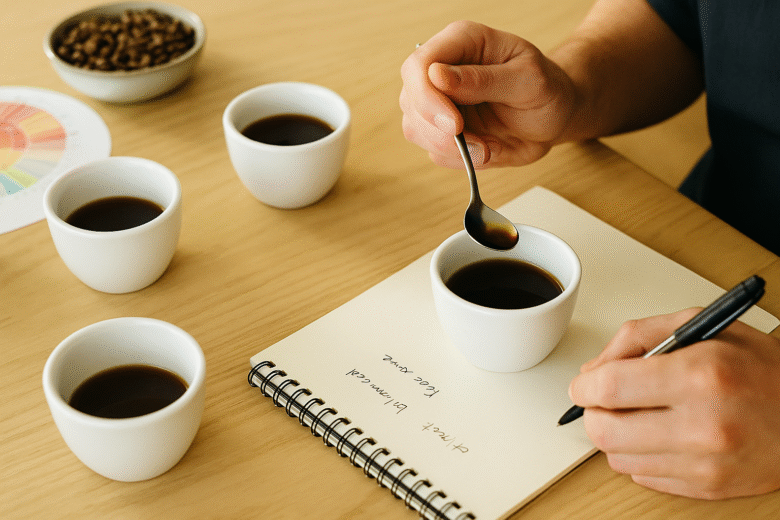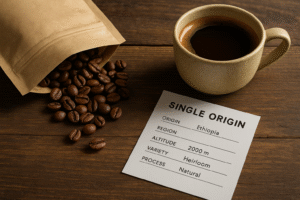Tasting coffee is more than just sipping and swallowing. It’s an experience that engages your senses and your brain—an exploration of aroma, texture, and flavor that deepens your appreciation of what’s in your cup.
If you’ve ever read tasting notes like “bergamot, brown sugar, and red apple” and thought, “I just taste coffee,” don’t worry. Tasting is a skill, not a talent—and like any skill, it can be developed with practice.
In this article, you’ll learn how to train your palate to identify coffee flavors more accurately and confidently, using simple techniques and mindful tasting habits.
Why Develop Your Palate?
Your palate is your sense of taste, and your ability to identify flavors is tied to your memory, focus, and exposure. By improving your palate, you can:
- Notice more complexity in every cup
- Choose coffees you genuinely enjoy
- Understand how origin, roast, and brew method affect flavor
- Communicate better with baristas, roasters, and fellow enthusiasts
- Turn your coffee habit into a richer, more rewarding ritual
Whether you’re a casual drinker or an aspiring professional, training your palate will transform how you experience coffee.
Step 1: Slow Down and Taste Mindfully
The first step is simply to slow down. Most people drink coffee while distracted—working, driving, or scrolling.
Instead:
- Sip intentionally
- Eliminate noise and distractions
- Focus on aroma, texture, and aftertaste
- Let the coffee cool—it reveals more flavor as it reaches room temperature
Start by describing your impressions. Is it sweet? Acidic? Bitter? Heavy or light? What does it remind you of?
You don’t need fancy words. Start with your instincts—then refine with practice.
Step 2: Use the Coffee Flavor Wheel
The Coffee Taster’s Flavor Wheel, developed by the Specialty Coffee Association, is a powerful tool for building vocabulary and precision.
It starts with broad categories like “fruity” or “nutty,” then branches into specific notes like “blueberry” or “hazelnut.”
Use it by:
- Tasting coffee and picking a general category
- Working inward or outward to identify more detail
- Comparing what you taste to the descriptions on the wheel
With time, this helps you connect taste memory to specific descriptors.
Step 3: Calibrate Your Taste Memory
Tasting notes are rooted in your memory of other foods. You can’t identify strawberry in coffee if you don’t clearly remember what strawberries taste like.
So, spend time tasting common flavor references:
- Fruits: apples, berries, citrus
- Nuts: almonds, hazelnuts, peanuts
- Sweeteners: sugar, honey, molasses
- Spices: cinnamon, clove, black pepper
- Chocolates: dark, milk, cocoa powder
- Teas: black, green, oolong
Do side-by-side comparisons. Smell and taste slowly. Take notes. This builds a sensory “database” in your brain that you’ll draw from when evaluating coffee.
Step 4: Taste Coffees Side by Side
The fastest way to learn is by comparing two or more coffees at once. This is how professionals do it during cuppings.
Choose coffees with clear differences:
- Different origins (Ethiopia vs Brazil)
- Different processes (washed vs natural)
- Different roast levels (light vs dark)
Brew them using the same method and ratio. Then taste slowly, going back and forth.
Ask:
- Which is sweeter?
- Which is more acidic?
- Which has more body?
- What flavors stand out?
Your brain is better at noticing differences than isolating one flavor.
Step 5: Use All Your Senses
Flavor is a combination of taste, smell, and mouthfeel.
Aroma
- Smell the grounds before brewing
- Smell the coffee after pouring
- Inhale through your nose as you sip
Taste
- Use your tongue to detect basic flavors: sweet, sour, bitter, salty (rare in coffee), umami (subtle)
Texture
- Is the body thin or thick?
- Is it silky, oily, gritty, or clean?
Finish
- What lingers after you swallow?
- Is it sweet, dry, bitter, or juicy?
Describing these sensations builds a complete flavor profile.
Step 6: Keep a Tasting Journal
Writing helps reinforce your learning. After each cup, jot down:
- Name, origin, and roast of the coffee
- Brewing method and ratio
- First impressions of aroma and flavor
- Notes on acidity, body, sweetness, and finish
- What you liked or didn’t
Over time, you’ll see patterns. Maybe you love natural Ethiopian coffees or medium-roasted Guatemalans. Your journal becomes a map of your preferences.
Step 7: Learn the Impact of Variables
Flavor in coffee is shaped by multiple factors. As you develop your palate, start exploring how these change what you taste:
Origin
- Ethiopian: floral, citrus, tea-like
- Kenyan: blackcurrant, tomato, bold acidity
- Colombian: caramel, red fruit, balance
- Brazilian: nutty, chocolatey, smooth
Process
- Washed: clean, bright, structured
- Natural: fruity, heavy, sweet
- Honey: balanced, sweet, medium body
Roast
- Light: preserves origin flavor, high acidity
- Medium: balanced sweetness and complexity
- Dark: bold, chocolatey, low acidity
Brewing Method
- Pour-over: clarity and detail
- French press: body and richness
- Espresso: intensity and concentration
- Cold brew: smooth, sweet, low acidity
Taste the same coffee using different methods to learn how each changes the flavor.
Step 8: Practice With Tasting Kits
Some companies sell coffee flavor training kits that include:
- Aromatic vials (fruit, spice, nut, etc.)
- Sensory games
- Tasting guides
While not essential, these tools can help you develop faster if you’re serious about sensory education.
Alternatively, build your own kit at home with small jars of herbs, spices, chocolates, and dried fruits.
Step 9: Taste With Others
Your palate improves faster when you taste with other people.
- Compare notes
- Describe what you’re tasting out loud
- Ask questions like “Do you get citrus or more stone fruit?”
- Don’t be afraid to disagree—flavor is subjective
Baristas, roasters, and coffee nerds love to talk tasting. Join a local cupping or online tasting event to accelerate your learning.
Step 10: Be Patient and Curious
Palate training is a long-term process. Don’t worry if you don’t taste blueberries on day one.
With time, your taste perception sharpens, your vocabulary expands, and your confidence grows. It’s not about being “right”—it’s about being attentive and curious.
Enjoy the journey of discovery with every cup.
Conclusion: Tasting Is a Skill, Not a Secret
Anyone can learn to identify coffee flavors. With a bit of structure, practice, and attention, you’ll move from “just coffee” to nuanced notes of citrus, nuts, florals, or chocolate.
Start slow, use your senses, and taste often. The more you explore, the more rewarding each sip becomes.
Your palate is your guide—train it, trust it, and let it lead you deeper into the world of coffee.

Marcio Luzardo is a coffee enthusiast and the voice behind Tudo Viraliza. With a passion for turning curiosity into practical knowledge, he shares easy-to-follow tips, guides, and insights to help readers enjoy better coffee every day. When he’s not writing, Marcio is exploring new brewing methods or diving into the rich stories that connect coffee to culture, lifestyle, and wellness.



